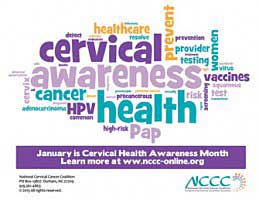
When hearing about such diseases as colon cancer and the tests to detect it, we sometimes shy away from addressing our risk factors and undergoing lifesaving detection.
But, when it comes to cervical cancer, the Centers for Disease Control and Prevention (CDC) say no woman should die of cervical cancer, and that the most important thing they can do to help prevent cervical cancer is to get screened regularly starting at age 21.
January is Cervical Health Awareness Month, sponsored by the National Cervical Cancer Coalition, and an opportunity to raise awareness about how women can protect themselves from cervical cancer
How is Cervical Cancer related to HPV?
“The main cause of cervical cancer is the human papillomavirus (HPV) passed from one person to another during sex. Most people who get exposed to the virus will not have any problems; however, others will go on to develop cancer,” said gynecological oncologist Dr. Tashanna Myers of the Baystate Regional Cancer Program, who noted two tests can help prevent cervical cancer or find it early.
Each year, about 12,000 women are diagnosed with cervical cancer and some one-third of them will die as a result of the cancer, which is highly preventable and treatable if detected early. Also, some 79 million Americans currently have HPV, and many who are infected don’t even know it. The virus causes no symptoms or health problems until it has become more invasive, resulting in abnormal vaginal bleeding or discharge, and pain during intercourse.
How do you catch cervical cancer early?
Cervical cancer can be detected early through the Pap test for women ages 21-65 and the HPV test for women 30 or older.
During a Pap test, also referred to as a Pap smear, cells are scraped from a woman’s cervix and sent to a lab for examination. If you get the HPV test along with the Pap test, the cells collected during the Pap test will also be tested for HPV at the lab.
Who should get the HPV vaccine?
Today there are HPV vaccines to protect against those types of HPV that often cause cervical, vaginal and vulvar cancers.
“Some parents do not want their child vaccinated against HPV because they feel it gives them a license to have sex. But, when we know that HPV is the causative force behind cervical, vaginal, and throat cancer, it is imperative we do something to prevent it. As oncology providers, we need to work alongside pediatricians in educating parents about its potential life-saving benefits and administer the vaccine before a young person becomes sexually active,” said Dr. Myers.
The CDC recommends that all 11- or 12-year-old girls get three doses of the HPV vaccine to protect against cervical cancer. Girls and young women ages 13 through 26 should get the vaccine if they have not received any or all doses when they were younger. The CDC also recommends vaccine for all boys ages 11 or 12, and for males ages 13 through 21 years, who did not get any or all of the three recommended doses when they were younger.
What are other Risk Factors?
Among a woman’s risk factors for cervical cancer include:
- Smoking
- Several sex partners
- Giving birth to three or more children
- Using birth control pills for a long time (five or more years)
- Having HIV (the virus that causes AIDS) or another condition that makes it hard for your body to fight off health problems.
How is cervical cancer treated?
Treatment and prognosis for cervical cancer is dependent on the stage of the disease, according to Dr. Myers.
For women with early stage disease (small cancers), a cure may be achieved with a hysterectomy, which is the surgical removal of the uterus and cervix. For some women, smaller procedures may be possible which allow the patient to keep a portion of the uterus, allowing her to have children in the future.
“Keeping any part of the uterus or cervix may increase your risk of recurrence, and treatment should be determined by a cervical cancer specialist,” said Dr. Myers, who noted with treatment, the five-year relative survival rate for early stage disease is 92%.
For women who have larger tumors and higher stages of disease, treatment can include chemotherapy and radiation therapy. In combination, these therapies can kill cancer cells and prevent the spread of the disease. Radiation can be given externally (outside of the body) and internally, near the cancer (inside the body).
“A cure can be harder to achieve for women with more advanced disease, and clinical trials offer more treatment options to work towards that goal,” said Dr. Myers.
Baystate is currently enrolling patients in a clinical trial for the treatment of locally advanced cervical cancer, as well as another looking at abnormal PAP tests and the risk of cancer. For more information about the trials, call 413-794-3188